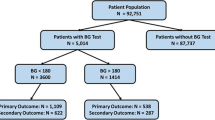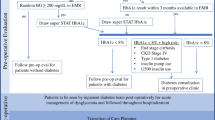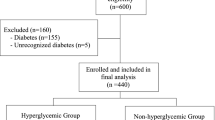Abstract
Introduction
To improve the detection and management of perioperative hyperglycemia at our tertiary cancer center, we implemented a glycemic control quality improvement initiative. The primary goal was to decrease the percentage of diabetic patients with median postoperative glucose levels > 180 mg/dL during hospitalization by 15% within 2 years.
Methods
A multidisciplinary team standardized preoperative screening, preoperative, intraoperative, and postoperative hyperglycemia management. We included all patients undergoing nonemergent inpatient and outpatient operations. We used a t test, rank sum, chi-square, or Fisher’s exact test to assess differences in outcomes between patients at baseline (BL) (10/2018–4/2019), during the first phase (P1) (10/2019–4/2020), second phase (P2) (5/2020–12/2020), and maintenance phase (M) (1/2021–10/2022).
Results
The analysis included 9891 BL surgical patients (1470 with diabetes), 8815 P1 patients (1233 with diabetes), 10,401 P2 patients (1531 with diabetes) and 30,410 M patients (4265 with diabetes). The percentage of diabetic patients with median glucose levels >180 mg/dL during hospitalization decreased 32% during the initiative (BL, 20.1%; P1, 16.9%; P2, 12.1%; M, 13.7% [P < .001]). We also saw reductions in the percentages of diabetic patients with median glucose levels >180 mg/dL intraoperatively (BL, 34.0%; P1, 26.6%; P2, 23.9%; M, 20.3% [P < .001]) and in the postanesthesia care unit (BL, 36.0%; P1, 30.4%; P2, 28.5%; M, 25.8% [P < .001]). The percentage of patients screened for diabetes by hemoglobin A1C increased during the initiative (BL, 17.5%; P1, 52.5%; P2, 66.8%; M 74.5% [P < .001]).
Conclusions
Our successful initiative can be replicated in other hospitals to standardize and improve glycemic control among diabetic surgical patients.


Similar content being viewed by others
References
Omar AS, et al. Association of time in blood glucose range with outcomes following cardiac surgery. BMC Anesthesiol. 2015;15(1):1–8.
Ouattara A, et al. Poor intraoperative blood glucose control is associated with a worsened hospital outcome after cardiac surgery in diabetic patients. J Am Soc Anesthesiol. 2005;103(4):687–94.
Shohat N, et al. Increased postoperative glucose variability is associated with adverse outcomes following orthopaedic surgery. Bone Joint J. 2018;100(8):1125–32.
Kiran RP, et al. The clinical significance of an elevated postoperative glucose value in nondiabetic patients after colorectal surgery: evidence for the need for tight glucose control? Ann Surg. 2013;258(4):599–605.
Van den Berghe G, et al. Intensive insulin therapy in critically ill patients. N Engl J Med. 2001;345(19):1359–67.
Investigators TN-SS. Intensive versus conventional glucose control in critically ill patients. N Engl J Med. 2009;360(13):1283–97.
United Stated Preventative Services Task Force. Abnormal blood glucose and type 2 diabetes mellitus: Screening. October 2015. https://www.uspreventiveservicestaskforce.org/uspstf/recommendation/screening-for-abnormal-blood-glucose-and-type-2-diabetes-october-2015. Accessed 24 Aug 2022.
Al-Niaimi AN, et al. Intensive postoperative glucose control reduces the surgical site infection rates in gynecologic oncology patients. Gynecol Oncol. 2015;136(1):71–6.
Acknowledgment
The authors thank Laura L. Russell, scientific editor, Research Medical Library, for editing this article. This research was in part supported by the National Institutes of Health through M.D. Anderson's Cancer Center Support Grant CA016672.
Author information
Authors and Affiliations
Corresponding author
Ethics declarations
Disclosure
The authors delare that they have no conflict of interest.
Additional information
Publisher's Note
Springer Nature remains neutral with regard to jurisdictional claims in published maps and institutional affiliations.
Prior presentations: A summary or an earlier analysis of this work has been presented at the American College of Surgery Quality Forum in 2021 and at the Institute for Healthcare Improvement Conference in 2021.
Rights and permissions
Springer Nature or its licensor (e.g. a society or other partner) holds exclusive rights to this article under a publishing agreement with the author(s) or other rightsholder(s); author self-archiving of the accepted manuscript version of this article is solely governed by the terms of such publishing agreement and applicable law.
About this article
Cite this article
Taylor, J.S., Fellman, B.M., Raty, S. et al. Detection and Management of Perioperative Hyperglycemia at a Tertiary Cancer Center. Ann Surg Oncol 31, 3017–3023 (2024). https://doi.org/10.1245/s10434-024-14986-7
Received:
Accepted:
Published:
Issue Date:
DOI: https://doi.org/10.1245/s10434-024-14986-7




